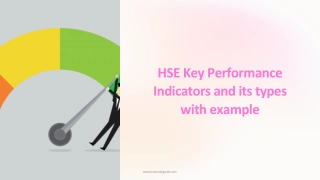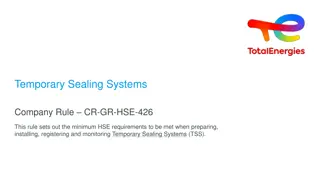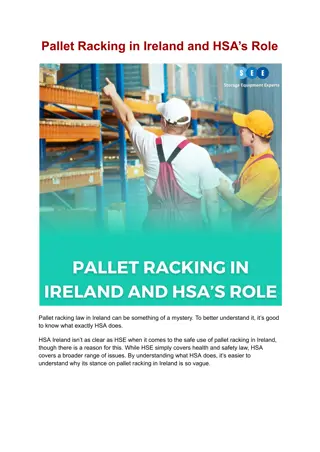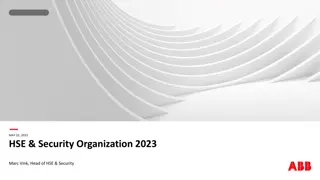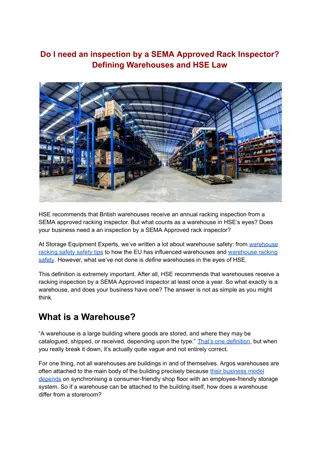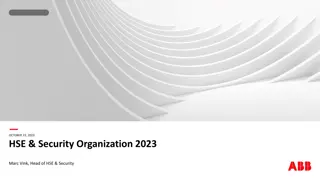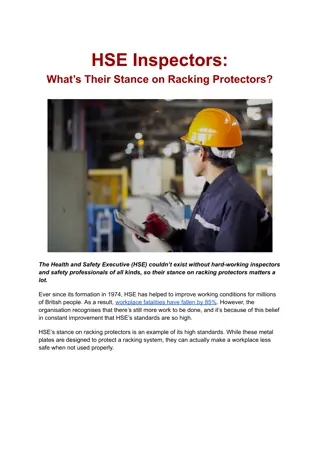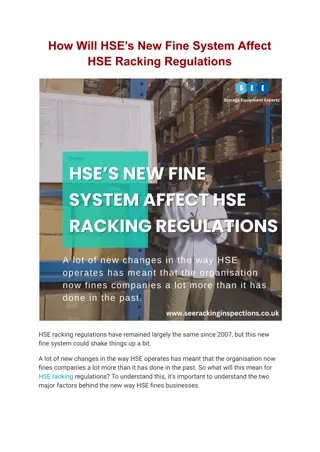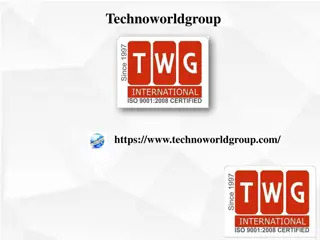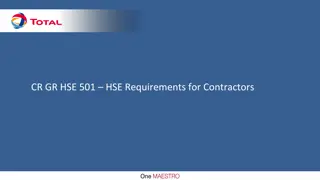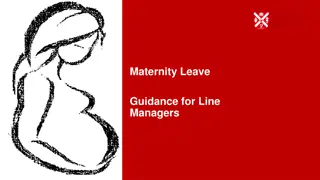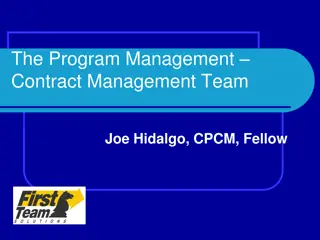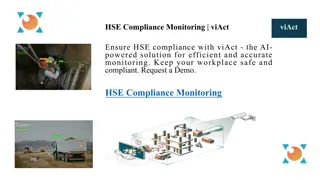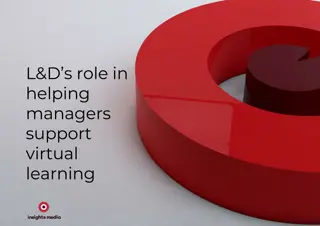
Safety Performance Trends and Analysis 2012-2017
Explore the safety performance trends and analysis from 2012-2017, highlighting achievements, incidents, exposures, and insights on key contributing factors to incidents. Dive into leaders' expectations, commitment to improvement, and identification of top exposures leading to serious injuries or catastrophic incidents.
Download Presentation

Please find below an Image/Link to download the presentation.
The content on the website is provided AS IS for your information and personal use only. It may not be sold, licensed, or shared on other websites without obtaining consent from the author. If you encounter any issues during the download, it is possible that the publisher has removed the file from their server.
You are allowed to download the files provided on this website for personal or commercial use, subject to the condition that they are used lawfully. All files are the property of their respective owners.
The content on the website is provided AS IS for your information and personal use only. It may not be sold, licensed, or shared on other websites without obtaining consent from the author.
E N D
Presentation Transcript
2016 1
2016 PDO achieved a 22% reduction in its LTIF down to 0.22. Regrettably, this good achievement was overshadowed by the THREE contractor work-related deaths We experienced Trend in our Total Recordable Case Frequency which stood at 0.98 injuries sustained per million manhours worked. Our exposure was 200 million manhours worked with kilometers driven exceeding 300 million. 2
Safety Performance 2012 - 2017 YTD Same Period 2016 Updated: 26th Mar2017 2012 2013 2014 2015 2016 2017 Fatalities PDO/Contractor fatality from work related incident 15 14 10 8 5 1 1 2 2 4 2 3 0 0 Third Party fatality from work related incident 1 1 2 0 0 0 0 Reportable, non recordable work related incident PDO/Contractor non work related private commuting 6 6 2 9 0 4 0 6 0 2 0 1 0 1 LTI injuries Worksite lost time injuries 47 44 58 51 43 7 6 42 39 49 45 37 6 6 Road traffic lost time injuries 5 5 9 6 6 1 0 No of people injured (excluding FAC) 187 167 179 181 192 34 51 Motor Vehicle Incidents (MVI) Severe MVI (LTIs, MTC, RWC and rollovers) 104 38 66 34 148 38 110 31 115 43 72 38 81 31 50 25 100 37 63 30 17 4 13 3 11 5 6 5 Minor MVI (first aid, damage) Rollover MVI Tier 1 Process Safety Incidents Tier 2 Process Safety Incidents (On-Plot ) 11 28 13 11 22 33 11 29 8 18 2 1 2 7 Incident rates LTIF (per million manhours) 0.29 1.17 0.41 0.16 0.25 0.26 0.98 0.59 0.15 0.44 0.32 0.97 0.44 0.16 0.27 0.28 0.98 0.29 0.11 0.18 0.22 0.98 0.33 0.12 0.21 0.16 0.76 0.25 0.06 0.19 0.14 1.18 0.16 0.07 0.09 TRCF (total injuries per million manhours) MVIR (motor vehicle incident rate per million km) Severe MVIR (LTI, rollover, MTC,RWC) Minor MVIR (first aid, damage only) Exposure Million man-hours worked 160 252 170 251 184.0 262.2 184.9 278.2 196.5 300.7 44.7 68.5 43.1 67.5 Million km driven
Long term incident rate trending LTI/MVI PDO Stats 7.00 350 LTIF MVIR Manhours Km Driven 6.00 300 5.00 250 Exposure (mln) 4.00 200 Frequency 3.00 150 2.00 100 1.00 50 0.00 0 1980 1981 1982 1983 1984 1985 1986 1987 1988 1989 1990 1991 1992 1993 1994 1995 1996 1997 1998 1999 2000 2001 2002 2003 2004 2005 2006 2007 2008 2009 2010 2011 2012 2013 2014 2015 2016 Increasing exposure: 300 mln KM & 200 mln Manhours 2016: LTIF is a PDO best ever performance 4
What do leaders want from their Safety Data Are we getting Better What are the Top contributing Factors to our Incidents and Exposures Are we followings through on our commitment to detect and correct variation What are the Top Exposures that are likely to cause someone to be seriously Injured or lead to a catastrophic incidents
Our top exposures Learning from Incidents Competence and Safety leadership Road Dropped objects Pinch points Lifting & Hoisting Top contributing factors?? Only top contributing factors? To our exposures? Based on our incidents analysis Stored energy Working at height Toxic gases Risk Management /MOC Heavy machinery Assurance Excavation
We need to keep on with the strategy of Getting our IVMS SJM control tower fully functioning so that we have better control on our vehicle movements Simplification of our procedures, processes and contracts Simplifying the PTW system Simplifying our governance and not just auditing for auditing sake Focusing on how best to learn from the incidents whilst avoiding information overload Focusing on competency instead of training Improving our consequence management so that it becomes more meaningful for the corporate level
My personal plea to you today. Don t switch which horse you back just because yours is not always in the lead 8
The danger of too much change, too soon Knee jerk reactions do not help us achieve our long term goals and overall strategy They distract, confuse and over-bear I have faith in our HSE strategy, but it must be given time to deliver 9
The PDO HSE MS simplification journey In development Launched Specifications Procedures Investigations Audits Visits Meetings Communications Actions Training Reviews Burden
2017 Our biggest threat in 2017 is retaining focus against other pressing matters 11
2017 Our performance is our value to the business Work hard, work smart, consider value to the business in everything you do. Consider any expenditure as if it were your own money. 12
2017 Where can each of us add the most value in HSE with minimal cost impact 13
2017 As HSE Managers, Advisers, Officers or Engineers, we have to think, how do we impact on the risk in our business, how can I be more effective, what do I need to improve? 14
2017 15

